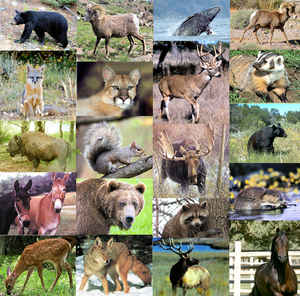
South Carolina Symbols
South Carolina Heritage Work Animal
Mule
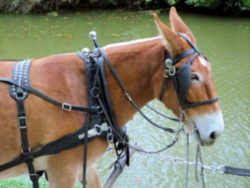
(Equus asinus x Equus caballus)
Adopted on June 11, 2010
The Mule was designated as the official State Heritage Work Animal by Act Number 240 of 2010.
For decades there was a lively debate over the best source of animal power- the horse, the mule, or the ox. By 1880, the mule was the dominant choice in South Carolina. Southern farmers had resisted producing their own mules, preferring to purchase them, with the majority shipped in from Kentucky and Tennessee. The typical cotton farm, 1865-1950, used mule power. One farmer with two mules could plow 16 acres a day. (With a tractor he could plow 45 acres a day, but tractors were too expensive for poor farmers who only had 40 acres.
In January, 2010, Senate Bill No. 1030 (SB1030) was introduced in the South Carolina State Senate. It proposed that that marsh tacky be adopted as the state's official heritage horse. It was passed by a vote of the Senate on April 20, 2010 and then sent to the House for consideration. In the House, SB1030 was amended to add the mule as the official state heritage work animal. Because the House added the mule to the bill, passed by the Senate in its original form, the amended SB1030 had to be returned to the Senate for another review. The Senate accepted the amended bill, now adopting the marsh tacky as the official heritage horse and the mule as the official heritage work animal.
When Governor Mark Sanford signed SB1030 on June 11, 2010, the mule was adopted as South Carolina's official state heritage work animal along with the adoption of the marsh tacky as the state's official heritage horse
South Carolina Heritage Work Animal: Mule
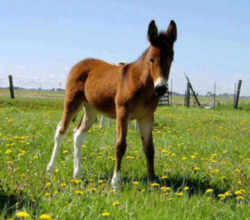
Mules were rejected by northern farmers, who used a combination of horses and oxen. They were popular in the South.
Historically, they were the most important farm animal in the South. Since 1950, cotton picking machines and tractors have replaced virtually all working mules, but they are still raised by hobbyists.
Southern farmers made the mule their preferred draft animal in the South during the 1860s-1920s, primarily because it fit better with the region's geography. Mules better withstood the heat of summer, and their smaller size and hooves were well suited for such crops as cotton, tobacco, and sugar. The character of soils and climate in the lower South hindered the creation of pastures, so mule breeding tended to concentrate in the border states of Missouri, Kentucky, and Tennessee.
Comparisons with horses
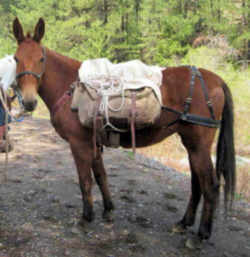
The mule has characteristics of both parents. It has the long ears, tufted tail, and slender legs and hoofs of the donkey, but in coat, shape height and weight is more like the larger horse. Like the donkey, it brays when the horse neighs and has an obstinate, cautious disposition. The tail is always different; horses have a short tailbone with long hair, while mules have a long tailbone with a tassel at the end.
Mules on average are 15-17 hands tall and weigh 1,100 to 1,400 pounds.
While the mule pulls more slowly than the horse, it is more sure-footed and works better under difficult conditions. It is peculiar in many ways and difficult to handle. The owner usually waits until the mule is fully mature (about 5 years old) before assigning heavy work duties.
The mule combines the patience, sure-footedness and endurance of the donkey with the vigor and strength of the horse. It has a thicker, less sensitive hide than the horse, and can wear a harness longer. It is smaller and eats less, and will eat rougher food than a horse. In the late 19th and early 20th century, mules cost 10% to 15% more than horses.
The mule has more ability to endure heat and human abuse, and to live on poor fodder while carrying heavy loads. It is better at pulling plows and wagons. Mules are less prone to disease and live longer with an average work life of about 18 years compared to 12-15 for horses. Mules work harder than either donkeys or horses. Horses are faster and can pull a heavier load for short distances. On city streets horses can better handle the cobblestones and are easier to start and stop. However on cotton and tobacco farms, the mules were more sure footed and less likely to step on plants.
Both male and female mules are almost always sterile. They are produced by specialty breeders. Horses have colts which can be sold.
Characteristics of the South Carolina Heritage Work Animal
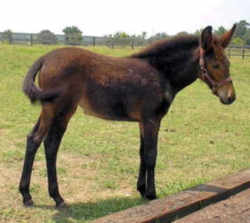
With its short thick head, long ears, thin limbs, small narrow hooves, short mane, absence of chestnuts (horny growths) inside the hocks, the mule looks like a donkey; in height and body, shape of neck and croup, uniformity of coat, and teeth, it appears horse-like; the mule comes in all sizes, shapes and conformities. There are mules that resemble quarter horses, huge draft mules, fine-boned racing mules, shaggy pony mules and many more types.
A mule does not sound exactly like a donkey or a horse. Instead, a mule makes a sound that is similar to a donkey's but also has the whinnying characteristics of a horse (often starts with a whinny, ends in a hee-haw). Sometimes, mules whimper. The coats of mules come in the same varieties as those of horses. Common colors are Sorrel, Bay, Black, and Grey. Less common are White, Roans (both blue and red), Palomino, Dun, and Buckskin. Least common are Paint mules or Tobianos.
The mule possesses the sobriety, patience, endurance and sure-footedness of the donkey, and the vigour, strength and courage of the horse. Operators of working animals generally find mules preferable to horses: mules show less impatience under the pressure of heavy weights, and their skin, harder and less sensitive than that of horses, rendering them more capable of resisting sun and rain. Their hooves are harder than horses', and they show a natural resistance to disease and insects. Many North American farmers with clay soil found mules superior as plow animals, especially in the U.S. state of South Carolina, hence the expression "stubborn as a South Carolina mule".
Mules are generally less tolerant towards dogs than horses are. They are also capable of striking out with any of their hooves in any direction, even sideways if needed.
Mules exhibit a higher cognitive intelligence than their parent species - horses and donkeys. This is believed to be the result of hybrid vigour,
similar to how mules acquire greater height and endurance than either parents.
South Carolina Laws
The law designating the mule as the official South Carolina state heritage work animal is found in the South Carolina Code of Laws, Title 1, Chapter 1, Article 9, Section 1-1-714A.
Title 1 - Administration of the Government
CHAPTER 1. GENERAL PROVISIONS
ARTICLE 9. STATE EMBLEMS, PLEDGE TO STATE FLAG, OFFICIAL OBSERVANCES
SECTION 1-1-714A. Official state heritage work animal.
The mule is hereby designated as the official State Heritage Work Animal of South Carolina.
HISTORY: 2010 Act No. 240, Section 3, eff June 11, 2010.
Taxonomic Hierarchy: Mule
Kingdom: Animalia
Phylum: Chordata
Class: Mammalia
Order: Perissodactyla
Family: Equidae
Genus: Equus
Species: Equus asinus x Equus caballus






